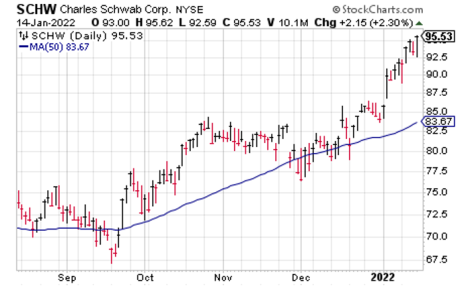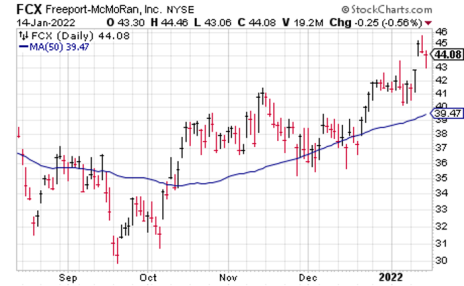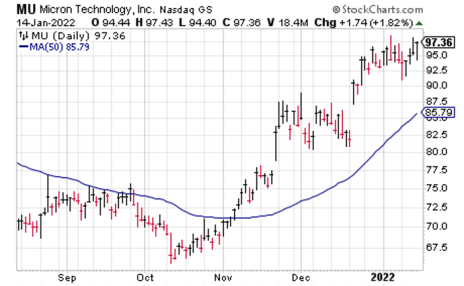With a fresh year of trading ahead of us and a rough year for growth stocks (hopefully) behind us I wanted to start today with a few big-picture growth investing strategies to consider as we ramp into 2022:
5 Growth Investing Rules for 2022
- Forget about Last Year: In 2020, I was a hero, up north of 60% in my advisory’s Model Portfolio. Last year, I was a dud, up just single digits as growth stocks lagged and (frankly) I made some snafus. But whether you were a hero or a zero last year, that was last year—put it on your long-term track record, sure, but don’t rest on your laurels (if you did great) or sulk (if you did poorly). Flip the page.
- Win Big, Lose Small: This is something even the best investors lose sight of—no matter what you’re playing with (growth stocks, value stocks, options, whatever), winning big and losing small is going to be the core reason you make money. Honestly, I’m always surprised at how many frustrating trades, round-trips and earnings duds come around … and yet, at year’s end, you still made money, often big money. Long story short, remember to cut your losses but aim big (or at least bigger) with your winners.
- Choose the Best, Leave the Rest: Sometimes, the market environment is such that you can throw a dart and make money; we all love those times. But this … isn’t one of those times. You don’t have to invest in blue chips, of course, but it’s almost always best to avoid the junk pile—for growth stocks, stick with those that have great stories, numbers and (at least resilient) charts, and let others toy with the speculative stuff that often tempts but usually disappoints. (A side benefit of this is you’ll have more conviction in the stuff you own, which will allow you to hold on through normal, tedious shakeouts—which in turn will allow you to develop bigger winners.)
- Follow a Plan: There is no perfect plan, just like there is no perfect investing system. But you’ll come out better if you have some roadmap that guides you rather than just going with your emotion. Obviously, if the evidence really changes (huge crack of support, trend change in the market, etc.), you should change as well—but for the most part it’ll be best to let things develop.
- Stay Optimistic: I’ve been at Cabot now for 22 1/2 years, and of course invested some before that, and during that time I’ve seen two of the biggest bear markets ever, a terrorist attack on our country, various wars and skirmishes, a housing/financial meltdown, rising interest rates, huge natural disasters, presidential impeachments, an oil crash, a trade war with the second biggest economy in the world, massive fiscal deficits and a pandemic. Through it all, our standard of living has (generally) gone up and the market has presented some great opportunities—especially in firms offering new, cutting edge technologies and products. There are down times (if you’re a growth investor, you’re in the middle of one right now), but let there be no doubt that there will be great opportunities ahead. So be sure to keep your eyes open for them, and apply these growth investing strategies when managing your portfolio.
Carnage for Growth Stocks
Now onto the current market, where for growth stocks there’s no question the environment is negative out there. Take a look at the Next Gen Nasdaq 100 (QQQJ), the ARK Innovation Fund (ARKK) and the Renaissance IPO Fund (IPO)—all are below their 200-day moving averages, and after mild/modest bounces in December, all are again probing their lows.
It’s even worse among individual stocks—coming into the New Year, just about all of the stocks I was watching closely for possible entry (and one stinker I literally bought a couple of days ahead of year-end) fell 10% or more in the first two days of the year.
Meanwhile, the market’s overall intermediate-term trend has actually turned up (it did the last week of December) and the Dow and broader indexes (small and mid-caps) are rising.
How to Invest in the Current Market
What to make of it? Some thoughts:
My first overall thing to say—especially in growth but even in other areas—is that making (and keeping) money right now is hard. For most trades, there’s not much of an edge. With so many sectors heading in different directions, the risk of a sharp rotation is growing. And even if you land a winner, few names are running away on the upside, instead making a decent move (10%? 15%?) and then pulling back and chopping around. For the most part, the juice isn’t worth the squeeze. That argues for a general cautious stance, and if you do develop some winners, raise stops and consider partial profits.
Second, and something I wrote about recently, is that it’s looking like many of the “old” big pandemic winners have topped out for a while—things like Cloudflare (NET) and Sea Limited (SE), which have fallen 50% in a straight line since mid-November (after monstrous runs) have likely seen their best days. For the next uptrend, focus on new names, which are more likely to be new leaders.
Third, though, I do wonder if we’re getting a near-term puke point in some of these growth stocks—and that some of these beaten-down names could bounce. I would never catch a falling knife, but (a) the declines in these growth stocks are getting pretty obvious, and (b) early January has a well-deserved reputation for whipsaws and reversals. If you play bounces, be on the lookout for one.
It’s not my traditional bailiwick, but I’m intrigued by many cyclical stocks on their long-term charts. Remember, things like the financials (XLF) and metals (XME) broke out of multi-year bases after the vaccine announcements in November 2020, had great runs into the spring/early summer last year, and then rested for many months.
For financial stocks, Schwab (SCHW) is already at new highs, while for metals, Freeport-McMoRan (FCX) also has a nice-looking launching pad.
Last but not least, the two areas within growth that aren’t completely biting the dust (though are still challenging) are networking, where there are big demand trends thanks to data center buildouts, 5G transitions and the like; and semiconductors, where demand is strong for both equipment and select chips.
For networking, one name to consider is Ciena (CIEN), which actually gapped up on earnings and ran higher in recent weeks, a rarity among anything tech related. If this latest pullback goes on a bit, it could be a decent risk-reward.
And for chip stocks, take a gander at Micron Technology (MU)—as opposed to stuff that’s already had a huge run, the stock built a massive launching pad for much of last year, and is perking up nicely of late. Of course, the firm is fairly cyclical with the pricing of DRAM and the like, but analysts see earnings up 47% this fiscal year (ending in August) and even more in 2023. It’s not likely to be a long-term winner, but if chips remain strong, MU could put on a good show.
What are your favorite growth investing strategies? Tell us about them in the comments below.





